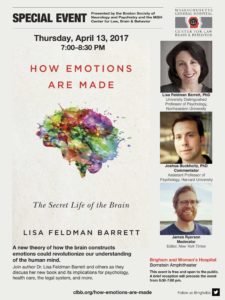The Economist reported on a recently published study by CLBB Chief Scientific Officer Dr. Lisa Feldman Barrett, which complicated our understanding of facial expression and emotions. Dr. Lisa Feldman was interviewed for the article and her study was featured prominently:
“As Lisa Feldman Barrett, one of the authors of the study, published in Psychological Science in the Public Interest, told the AAAS meeting in Seattle, ‘We surprised ourselve’. Dr Feldman Barrett is a psychologist at Northeastern University in Boston, Massachusetts, and along with her colleagues she found that, on average, adults in urban cultures scowled when they were angry 30% of the time. Which meant that some 70% of the time they did not scowl when angry. Instead, they did something else with their faces. People also scowled when they were not angry. ‘They scowl when they’re concentrating, they scowl when someone tells them a bad joke, they scowl when they have gas, they scowl for lots of reasons,’ says Dr Feldman Barrett.
A scowl, the researchers concluded, is certainly one expression of anger. But it is not the only way people express that emotion. The ambiguous nature of facial expressions was not restricted to anger, but seemed valid for all six of the emotional categories that they examined: anger, disgust, fear, happiness, sadness and surprise.”
Additionally, the article also highlighted the significant of this research:
“All this raises questions about the efforts of information-technology companies to develop artificial-intelligence algorithms which can recognise facial expressions and work out a person’s underlying emotional state. Microsoft, for example, claims its “Emotion api” is able to detect what people are feeling by examining video footage of them. Another of the study’s authors, however, expressed scepticism. Aleix Martinez, a computer engineer at Ohio State University, said that companies attempting to extract emotions from images of faces have failed to understand the importance of context.”
Read the full article, “Do not rely on facial expressions for how people are feeling”, published by The Economist on February 20, 2020.




